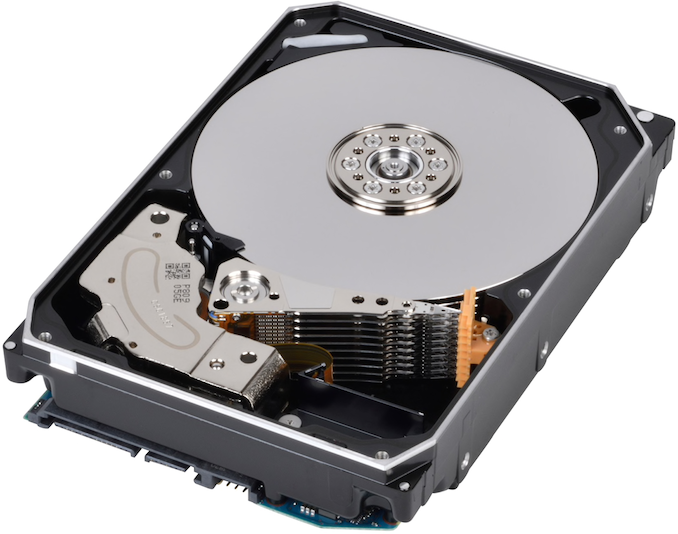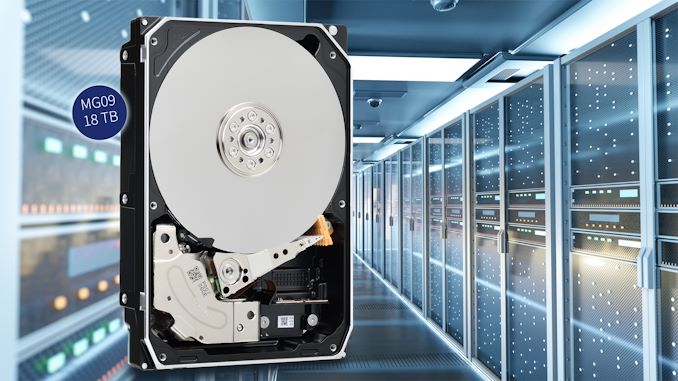Toshiba Unveils World's First FC-MAMR HDD: 18 TB, Helium Filled
by Anton Shilov on February 19, 2021 9:50 AM EST- Posted in
- Storage
- Toshiba
- HDDs
- MAMR
- Helium HDD
- Showa Denko
- MG09

Toshiba this week announced the industry's first hard drive featuring flux-control microwave-assisted magnetic recording (FC-MAMR) technology. The new MG09-series HDDs are designed primarily for nearline and enterprise applications, they offer an 18 TB capacity along with an ultra-low idle power consumption.
The Toshiba MG09-series 3.5-inch 18 TB HDD are based on the company's 3rd generation nine-platter helium sealed platform that features 18 heads with a microwave-emitting component which changes magnetic coercivity of the platters before writing data. The HD disks are made by Showa Denko K.K. (SDK), a long-time partner of Toshiba. Each aluminum platter is about 0.635 mm thick, it features an areal density of around 1.5 Tb/inch2 and can store up to 2 TB of data. The MG09 family also includes a 16 TB model which presumably features a lower number of platters (based on the same performance rating).
For modern enterprise and nearline 3.5-inch HDDs, Toshiba's MG09-series drives uses a motor with a 7200-RPM spindle speed. The HDDs are also equipped with a 512 MB buffer and are rated for a 281 MB/s maximum sustained data transfer rate. Unfortunately, Toshiba has not updated the random access performance of the new products, though it is likely that their per-TB IOPS performance is lower when compared to predecessors. The manufacturer will offer its new drives both with SATA 3.3 (6 Gbps) and SAS 3.0 (12 Gbps) interfaces as well as a selection of logical data block length.
One of the noteworthy things about Toshiba's MG09-series FC-MAMR HDDs is their power consumption. In active idle mode, they typically consume 4.16/4.54 Watts (SATA/SAS models), which is considerably lower when compared with Seagate's Exos X18 as well as Western Digital's Ultrastar DC HC550. As far as power consumption efficiency at idle (large hard drives could spend plenty of time idling) is concerned, the 18 TB MG09 is an undeniable champion consuming just 0.23 Watts per TB (in case of the SATA version). Meanwhile, the new drives are rated for 8.35/8.74 Watts (SATA/SAS SKUs) during read/write operations, which is higher when compared to the DC HC550 as well as predecessors from the MG07 and the MG08-series.
| Brief Specifications of Toshiba's MG09 HDDs | |||||
| Capacity | 18 TB | 16 TB | |||
| Platters | 9 | 8 | |||
| Heads | 18 | 16 | |||
| Recording Technology | Flux-control microwave-assisted magnetic recording (FC-MAMR) |
||||
| RPM | 7200 RPM | ||||
| Interface | SATA 6 Gbps/SAS 12 Gbps | ||||
| DRAM Cache | 512 MB | ||||
| Persistent Write Cache | Yes | ||||
| Helium-Filling | Yes | ||||
| Sequential Data Transfer Rate (host to/from drive) | 281 MB/s | ||||
| MTBF | 2.5 million | ||||
| Rated Annual Workload | 550 TB | ||||
| Acoustics (idle) | 20 dB | ||||
| Power Consumption | Random read/write | SATA: 8.35 W SAS: 8.74 W |
|||
| Idle | SATA: 4.16 W SAS: 4.54 W |
||||
| Warranty | 5 Years | ||||
As the MG09 family of hard drives are intended for datacenter racks that accommodate hundreds of vibrating HDDs, they feature numerous enhancements to ensure consistent performance, reliability, and durability. Typically such enhancements include top and bottom attached motors, RVFF, as well as environmental sensors. Like all modern drives for 24/7 applications, Toshiba's MG09-series units are rated for a 550 TB average annualized workload, 2.5 million hours MTBF, and are covered with a standard five-year warranty.
Also, the new MG09 hard drives support Toshiba’s persistent write cache (PWC) with power loss protection (PLP) technology, which is crucial for 4K sector drives that emulate 512B sectors. The PWC with PLP feature guards data in case of power loss while performing read-modify-write (RMW) operation to align the source write request with the physical sectors it has to modify. This capability allows the company to address its clients who run legacy systems that still require high capacities. Also, the new MG09 family includes Sanitize Instant Erase (SIE) and Self Encrypting Drive (SED) models.
Toshiba has been working on its MG09-series FC-MAMR HDDs for at least two years already. Last year the company said it had made 'significant investments in manufacturing facilities' and promised to start shipments of its 18 TB hard drives by March 31, 2021. This week the company reaffirmed its plan and said it would begin sample shipments of its 18 TB MG09-series MAMR HDDs 'at the end of March 2021.'
Source: Toshiba











23 Comments
View All Comments
edzieba - Friday, February 19, 2021 - link
I'll wait for the Magnetic (flux) Control - Heat Assisted Magnetic Recording technology drives!boeush - Friday, February 19, 2021 - link
Impossible: can't touch them...The Von Matrices - Friday, February 19, 2021 - link
Why has the industry not just moved to native 4K sectors already?Yojimbo - Friday, February 19, 2021 - link
I don't know, but perhaps there's a lot of software out there that would break.Dolda2000 - Saturday, February 20, 2021 - link
Probably little point to do so. The software that can support 4k sectors can simply write 4k at a time and have basically the same effect as if the sector size actually were 4k, while the software that hasn't been updated to support it can still work, and on the hard drive side there's probably just a few lines of extra code to virtualize 512 byte sectors.wwenze - Sunday, February 21, 2021 - link
I don't know about HDD, but on SSD the minimum programmable page size is already 16kbytes per plane, while a superpage which is multiple planes+dies in parallel can be 16 times that or even bigger for higher throughput. Which will become kind of dumb if every 100byte text files take up 16kbytes minimum.Point is, if the hardware still has to eventually use virtual sectors regardless of the industry standard, why not stick to a current standard that is also more space efficient.
zybex - Thursday, February 25, 2021 - link
Pretty much every single drive today has 4K native sectors with 512B emulation for compatibility. It has been this way for many years already. The article even mentions that this drive has PWC to deal with 512b emulation.Windows/Linux/MacOS all detect and use native 4K sectors (no emulation needed). It matches the CPU page size, so it simplifies things a bit.
Operandi - Friday, February 19, 2021 - link
I bet these will perform a lot better than the previous generation that were filled with Skippy extra crunchy PB.ZoZo - Friday, February 19, 2021 - link
Why can't we have active noise specification?I'm guessing these have no restraint in terms of noise, and must be in the 36-ish dB.
brontes - Friday, February 19, 2021 - link
0.08 dwpd, hard pass.